
The economy of Romania is a complex high-income economy with a skilled labour force, ranked 12th in the European Union by total nominal GDP and 7th largest when adjusted by purchasing power parity. The World Bank notes that Romania’s efforts are focused on accelerating structural reforms and strengthening institutions in order to further converge with the European Union. The country's economic growth has been one of the highest in the EU since 2010, with the first half of 2022 seeing an unexpected 5.8% increase.

Constantin Mugur Isărescu is the Governor of the National Bank of Romania, a position he has been holding since September 1990, with the sole exception of a period of time of one year, during which he served as Prime Minister of Romania. In addition, he is also a member of the Romanian Academy.
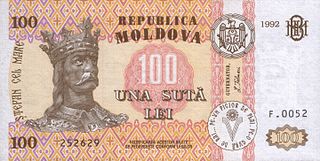
The leu is the currency of Moldova. Like the Romanian leu, the Moldovan leu is subdivided into 100 bani. The name of the currency originates from a Romanian word which means "lion".

The Romanian leu is the currency of Romania. It is subdivided into 100 bani, a word that means both "money" and "coin" in the Romanian language.

The National Bank of Romania is the central bank of Romania and was established in April 1880. Its headquarters are located in the capital city of Bucharest.
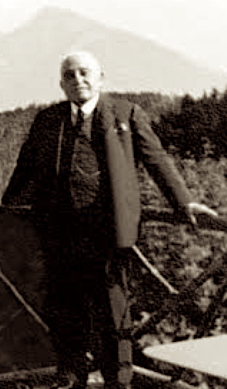
Grigore Antipa was a Romanian naturalist, zoologist, ichthyologist, ecologist, oceanologist, Darwinist biologist who studied the fauna of the Danube Delta and the Black Sea. Between 1892 and 1944 he was the director of the Bucharest Natural History Museum, which now bears his name. He is also considered to be the first person to modernize the diorama by emphasizing the three-dimensional aspect and first to use dioramas in a museum setting. He is the scientist who reorganized the Grigore Antipa National Museum of Natural History in the new building that today bears his name, designed by the architect Grigore Cerchez, built in 1906 and inaugurated by Carol I of Romania in 1908. He was elected as member of the Romanian Academy in 1910 and was also a member of several foreign academies. Grigore Antipa founded a school of hydrobiology and ichthyology in Romania.

Ecaterina Teodoroiu was a Romanian woman who fought on the front and died in World War I, and is regarded as a heroine of Romania.
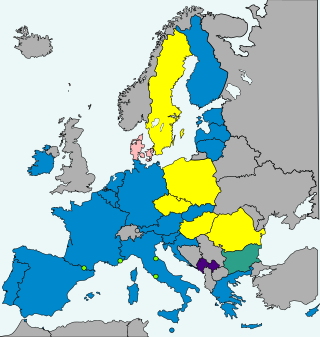
Romania's national currency is the leu. After Romania joined the European Union (EU) in 2007, the country became required to replace the leu with the euro once it meets all four euro convergence criteria, as stated in article 140 of the Treaty on the Functioning of the European Union. As of 2022, the only currency on the market is the leu and the euro is not yet used in shops. The Romanian leu is not part of the European Exchange Rate Mechanism, although Romanian authorities are working to prepare the changeover to the euro. To achieve the currency changeover, Romania must undergo at least two years of stability within the limits of the convergence criteria. The current Romanian government established a self-imposed criterion to reach a certain level of real convergence as a steering anchor to decide the appropriate target year for ERM II membership and Euro adoption. In March 2018, the National Plan for the Adoption of the Euro scheduled the date for euro adoption in Romania as 2024. Nevertheless, in early 2021, this date was postponed to 2027 or 2028, and once again to 2029 in late 2021 and then pushed to 2026.
Since 1867 there have been four successive currencies in Romania known as the leu. This article details the banknotes denominated in the leu and its subdivision the ban since 1917, with images.

The ten lei banknote is one of the circulating denominations of the Romanian leu. It is the same size as the 20 Euro banknote.

The current one leu banknote is the smallest circulating denomination of the Romanian leu. It is the same size as the 5 Euro banknote.

The five lei banknote is one of the circulating denomination of the Romanian leu. It is the same size as the 10 Euro banknote.
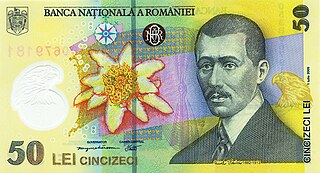
The fifty-lei banknote is one of the circulating denomination of the Romanian leu. It is the same size as the 50 Euro banknote.

The one hundred lei banknote is one of the circulating denomination of the Romanian leu. It is the same size as the 2002 series 100 Euro banknote.

The two hundred lei banknote is one of the circulating denomination of the Romanian leu.

The five hundred lei banknote is the highest of the circulating denomination of the Romanian leu. It is the same size as the 200 Euro banknote.
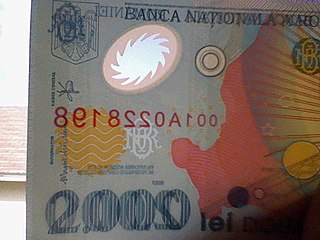
In celebration of the total solar eclipse of August 11, 1999, the National Bank of Romania (BNR) decided to issue a commemorative two thousand Romanian lei banknote. This was the last solar eclipse of the millennium and was visible across southern Romania. Since it was the last eclipse of the millennium, the denomination was chosen to be 2000 in respect to the upcoming year. These notes were issued as legal tender.

The Great Depression of 1929–1933, which affected the whole world, had several consequences in the Kingdom of Romania. Romania had been among the winner countries of World War I. It received several new territories, with many natural resources. However, the war caused heavy human and economic losses to the country. Romania had to fight inflation and the non-convertibility of its currency, the Romanian leu. Romania then had a fundamentally agrarian economy, with agriculture accounting for 63.2% of the national production. The Great Depression affected Romania on several ways. For example, in 1933, the net national income was of 172,614,000,000 lei, only 62% of that of 1929, which was of 275,180,000,000 lei. To fight the economic crisis, the National Bank of Romania carried out various measures and the country took various loans. Help was also called upon from France.
Events from the year 1947 in Romania. The year saw the abdication of Michael I of Romania and foundation of the Romanian People's Republic.

















